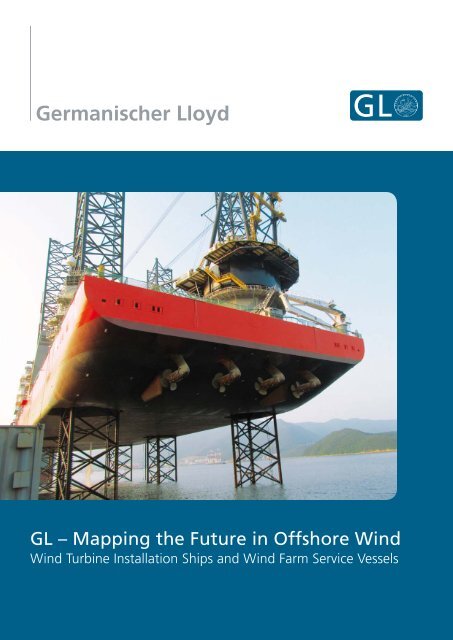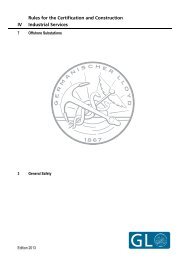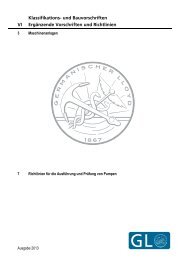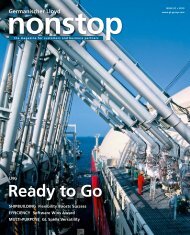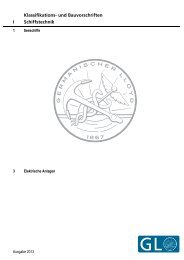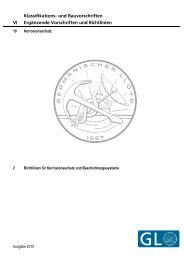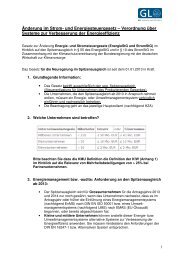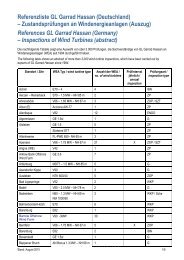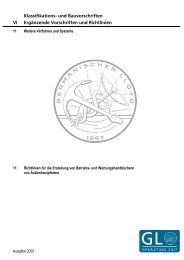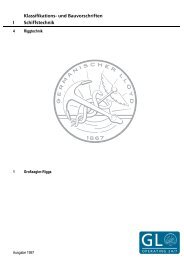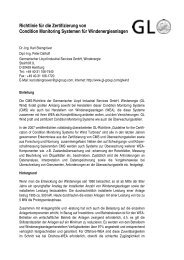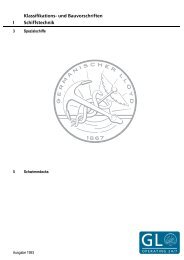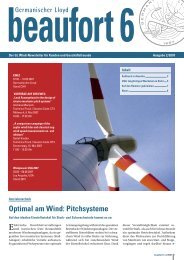GL – Mapping the Future in Offshore Wind - Germanischer Lloyd
GL – Mapping the Future in Offshore Wind - Germanischer Lloyd
GL – Mapping the Future in Offshore Wind - Germanischer Lloyd
You also want an ePaper? Increase the reach of your titles
YUMPU automatically turns print PDFs into web optimized ePapers that Google loves.
<strong>GL</strong> <strong>–</strong> <strong>Mapp<strong>in</strong>g</strong> <strong>the</strong> <strong>Future</strong> <strong>in</strong> <strong>Offshore</strong> W<strong>in</strong>d<br />
W<strong>in</strong>d Turb<strong>in</strong>e Installation Ships and W<strong>in</strong>d Farm Service Vessels
The power of <strong>in</strong>novation:<br />
offshore w<strong>in</strong>d energy<br />
Dynamic growth<br />
W<strong>in</strong>d energy is one of <strong>the</strong> key renewable energy sources that<br />
will make a significant contribution towards clean and <strong>in</strong>dependent<br />
energy around <strong>the</strong> world. As a reflection of this, <strong>the</strong><br />
w<strong>in</strong>d energy <strong>in</strong>dustry is <strong>in</strong> a period of significant growth and<br />
<strong>in</strong> Europe <strong>the</strong> ma<strong>in</strong> driver is a political one: by 2020 <strong>the</strong> EU<br />
plans to cover 20 % of its primary energy consumption us<strong>in</strong>g<br />
renewable sources. W<strong>in</strong>d energy will play a key role as 10,000<br />
offshore w<strong>in</strong>d turb<strong>in</strong>es are expected to be <strong>in</strong>stalled <strong>in</strong> European<br />
offshore waters.<br />
A wide range of vessels<br />
This development presents ship owners, operators and<br />
yards with considerable opportunities <strong>in</strong> <strong>the</strong> construction<br />
and deployment of suitable vessels. The range of vessels<br />
needed to develop, <strong>in</strong>stall and operate w<strong>in</strong>d farms comprises<br />
multiple crafts such as W<strong>in</strong>d Turb<strong>in</strong>e Installation Ships (WTIS),<br />
crew boats as well as o<strong>the</strong>r types such as survey vessels,<br />
offshore support vessels, cable-lay<strong>in</strong>g vessels and anchor<br />
handl<strong>in</strong>g tugs.<br />
2
The power of <strong>in</strong>novation: offshore w<strong>in</strong>d energy<br />
Increas<strong>in</strong>g demand<br />
Globally, <strong>the</strong> offshore w<strong>in</strong>d market is grow<strong>in</strong>g rapidly. In Europe,<br />
UK development is forecast to rise steadily, while projects <strong>in</strong><br />
Germany and <strong>the</strong> Ne<strong>the</strong>rlands are expected to beg<strong>in</strong> development<br />
on a large scale, and o<strong>the</strong>r European markets are also<br />
becom<strong>in</strong>g <strong>in</strong>creas<strong>in</strong>gly active, as will <strong>the</strong> North American and<br />
Ch<strong>in</strong>ese markets.<br />
At present, approximately 1GW is <strong>in</strong>stalled per year, which is<br />
expected to rise to 5GW. This is equivalent to an <strong>in</strong>crease of:<br />
ÂÂfrom 250 to 1,000 turb<strong>in</strong>es per year<br />
ÂÂfrom 150 to 700 km of export cable<br />
ÂÂfrom 4 to 20 vessels to <strong>in</strong>stall support structures<br />
ÂÂfrom 3 to 14 vessels to <strong>in</strong>stall turb<strong>in</strong>es<br />
ÂÂfrom 1 to 8 vessels to repair turb<strong>in</strong>es<br />
ÂÂfrom 300 to 500 support vessels<br />
Current figures from <strong>the</strong> European W<strong>in</strong>d Energy Association<br />
(EWEA) state that <strong>in</strong> 2010, <strong>the</strong> total <strong>in</strong>stalled offshore capacity<br />
reached 3,000 MW. This meets 0.3 % of EU electricity<br />
demand. For <strong>the</strong> year 2030, 150,000 MW of <strong>in</strong>stalled offshore<br />
capacity are projected, which will meet between 13 and 17 %<br />
of total EU electricity demand.<br />
A complex challenge requires<br />
<strong>in</strong>novative solutions<br />
<strong>Offshore</strong> w<strong>in</strong>d farm<strong>in</strong>g requires a series of highly specialized<br />
vessels adapted to <strong>the</strong> particular challenges faced <strong>in</strong> this sector:<br />
ÂÂlarge units: w<strong>in</strong>d turb<strong>in</strong>e <strong>in</strong>stallation, construction and<br />
cable-lay<strong>in</strong>g vessels<br />
ÂÂsmaller units: ma<strong>in</strong>tenance and supply vessels<br />
ÂÂcrew transport vessels<br />
ÂÂtransportation vessels for all equipment from foundation to<br />
blades equipment<br />
Increas<strong>in</strong>g turb<strong>in</strong>e sizes and weights need to be taken <strong>in</strong>to<br />
consideration, as <strong>the</strong> offshore w<strong>in</strong>d <strong>in</strong>dustry moves <strong>in</strong>to<br />
deeper water and fur<strong>the</strong>r from <strong>the</strong> shore beyond <strong>the</strong> so-called<br />
20:20 envelope (20 m water depth, 20 km from shore). This<br />
requires vessels that have a high tolerance to adverse wea<strong>the</strong>r<br />
conditions <strong>–</strong> speed and resilience to seastate are key factors<br />
for w<strong>in</strong>d farm <strong>in</strong>stallation and service vessels, just as reliability<br />
and flexibility are key factors <strong>in</strong> <strong>the</strong>ir successful operation.<br />
In short, offshore w<strong>in</strong>d farm<strong>in</strong>g requires highly sophisticated<br />
vessels that operate <strong>in</strong> challeng<strong>in</strong>g surround<strong>in</strong>gs.<br />
approximately 6,900 experts across 80 countries and <strong>in</strong> more<br />
than 200 locations.<br />
Today, we are proud of our lead<strong>in</strong>g position <strong>in</strong> <strong>the</strong> field of w<strong>in</strong>d<br />
turb<strong>in</strong>e <strong>in</strong>stallation vessels and w<strong>in</strong>d farm service vessels. We<br />
explore and implement new solutions for <strong>the</strong> different vessel<br />
types required <strong>in</strong> <strong>the</strong> offshore w<strong>in</strong>d sector. This <strong>in</strong>cludes:<br />
ÂÂnew ideas and <strong>in</strong>novative solutions<br />
ÂÂexpertise from concept to operation<br />
ÂÂimplement<strong>in</strong>g sophisticated eng<strong>in</strong>eer<strong>in</strong>g challenges<br />
ÂÂdevelop<strong>in</strong>g Rules<br />
ÂÂclassification of all vessels needed to develop,<br />
<strong>in</strong>stall and operate offshore w<strong>in</strong>d farms<br />
ÂÂexpert support <strong>in</strong> negotiat<strong>in</strong>g <strong>the</strong> difficult terra<strong>in</strong> of<br />
<strong>in</strong>ternational regulations and compliancy.<br />
Our achievements have led us to:<br />
ÂÂset up a dedicated <strong>Offshore</strong> Service Vessel (OSV)<br />
department<br />
ÂÂdevelop rules for OSVs: hull and mach<strong>in</strong>ery<br />
ÂÂdevelop rules for crew boats<br />
ÂÂpresent OSV-related expertise at panel discussions,<br />
conferences and to ship owners <strong>in</strong> Europe, Ch<strong>in</strong>a,<br />
South Korea, U.A.E. and USA<br />
ÂÂprovide consultancy <strong>in</strong> <strong>the</strong> OSV sector<br />
ÂÂsupport various shipyards with our pool of <strong>in</strong>-depth<br />
knowledge<br />
<strong>GL</strong> acts as advisor to governments, <strong>the</strong> IMO, flag states and<br />
port states. We are ideally placed to provide guidance on<br />
compliancy with all current and upcom<strong>in</strong>g regulations. As a<br />
classification society, we have accompanied <strong>the</strong> design and<br />
construction of a number of w<strong>in</strong>d farm vessels, mak<strong>in</strong>g us<br />
your expert partner for all lifecycle stages of offshore w<strong>in</strong>d<br />
<strong>in</strong>stallation and support vessels.<br />
Jan Schreiber<br />
Ship Type Expert<br />
<strong>Offshore</strong> Service and<br />
Work<strong>in</strong>g Vessels<br />
Phone: +49 40 36149-5235<br />
Jan.Schreiber@gl-group.com<br />
<strong>GL</strong>: your one-stop shop for offshore<br />
w<strong>in</strong>d farm vessels<br />
Founded <strong>in</strong> 1867 as a maritime classification society, <strong>Germanischer</strong><br />
<strong>Lloyd</strong> (<strong>GL</strong>) has expanded to provide a wide range of<br />
classification, certification, software and tra<strong>in</strong><strong>in</strong>g services.<br />
We can po<strong>in</strong>t to 240 years of experience and a network of<br />
"<strong>Offshore</strong> w<strong>in</strong>d farm<strong>in</strong>g requires highly sophisticated<br />
vessels. At <strong>GL</strong> we are proud of <strong>the</strong> range and depth of<br />
expertise we can offer this rapidly expand<strong>in</strong>g market.<br />
From w<strong>in</strong>d turb<strong>in</strong>e <strong>in</strong>stallation and construction vessels,<br />
to ma<strong>in</strong>tenance, supply and crew transport vessels."<br />
3
The <strong>GL</strong> Group <strong>–</strong> global knowledge<br />
and local expertise<br />
Unique solutions from concept to operation<br />
Rules and classification<br />
<strong>Germanischer</strong> <strong>Lloyd</strong> offers rules and guidel<strong>in</strong>es that cover all<br />
aspects of offshore projects: design, development, construction,<br />
security, operation and management. <strong>GL</strong> expertise is currently<br />
supervis<strong>in</strong>g several offshore service vessel newbuild<strong>in</strong>g and<br />
re-build<strong>in</strong>g projects, <strong>in</strong>clud<strong>in</strong>g self-elevat<strong>in</strong>g units for w<strong>in</strong>d<br />
turb<strong>in</strong>e <strong>in</strong>stallation, crew boats, accommodation units, anchor<br />
handlers, cable layers, and various supply and ma<strong>in</strong>tenance<br />
vessels.<br />
Source: HOCHTIEF Solutions<br />
<strong>GL</strong> Rules are constantly be<strong>in</strong>g f<strong>in</strong>e-tuned to reflect advances <strong>in</strong><br />
technology across <strong>the</strong> <strong>in</strong>dustry. The recently issued Rules for<br />
<strong>the</strong> Classification and Construction of <strong>Offshore</strong> Service Vessels<br />
and Underwater Technology <strong>in</strong>clude more than 20 special<br />
notations for <strong>the</strong> wide variety of vessels and tasks undertaken<br />
<strong>in</strong> offshore projects. <strong>GL</strong> Rules <strong>in</strong>clude:<br />
ÂÂ<strong>GL</strong> Rules for <strong>Offshore</strong> Service Vessels <strong>–</strong> Hull Structures<br />
<strong>Germanischer</strong> <strong>Lloyd</strong> Classification<br />
We develop Rules based on state-of-<strong>the</strong>-art eng<strong>in</strong>eer<strong>in</strong>g knowledge<br />
and procedures, as well as provid<strong>in</strong>g guidance for ship<br />
owners, shipyards and <strong>the</strong> maritime supply <strong>in</strong>dustry. We offer<br />
classification services, plan approval and newbuild<strong>in</strong>g supervision,<br />
maritime systems and solutions, and tra<strong>in</strong><strong>in</strong>g.<br />
<strong>GL</strong> Garrad Hassan offers <strong>in</strong>dependent technical and eng<strong>in</strong>eer<strong>in</strong>g<br />
services, products, and tra<strong>in</strong><strong>in</strong>g courses to <strong>the</strong> onshore<br />
and offshore w<strong>in</strong>d, wave, tidal and solar sectors. <strong>GL</strong> Garrad<br />
Hassan has provided more <strong>in</strong>dependent assessments for<br />
operational w<strong>in</strong>d farms than any o<strong>the</strong>r company.<br />
<strong>GL</strong> Noble Denton provides consult<strong>in</strong>g, design, assurance and<br />
project execution services. <strong>GL</strong> Noble Denton comb<strong>in</strong>es excellent<br />
eng<strong>in</strong>eer<strong>in</strong>g and analytical skills with operational experience<br />
to design, build, <strong>in</strong>stall and operate maritime onshore and<br />
offshore assets.<br />
<strong>Future</strong>Ship offers specialised consult<strong>in</strong>g services <strong>in</strong> <strong>the</strong> fields<br />
of maritime strategy, ship design, operations, and compliance.<br />
<strong>Future</strong>Ship’s consult<strong>in</strong>g expertise is complemented by <strong>in</strong>-depth<br />
market <strong>in</strong>telligence, advanced eng<strong>in</strong>eer<strong>in</strong>g solutions and<br />
sophisticated measurement services.<br />
ÂÂNew <strong>GL</strong> Rules for Dynamic Position<strong>in</strong>g System<br />
ÂÂ<strong>GL</strong> Guidel<strong>in</strong>es for Gas as Ship Fuel<br />
ÂÂ2011 <strong>GL</strong> Rules for <strong>Offshore</strong> Service Vessels <strong>–</strong> Mach<strong>in</strong>ery<br />
Installations<br />
ÂÂNew Rules for Load<strong>in</strong>g Gears on seago<strong>in</strong>g ships and<br />
offshore <strong>in</strong>stallations<br />
Ensur<strong>in</strong>g compliance for all vessel types<br />
One of <strong>the</strong> major challenges of all offshore <strong>in</strong>stallation and<br />
service craft is ensur<strong>in</strong>g compliancy for vessels that <strong>in</strong>tegrate<br />
sophisticated concepts and fulfil many different purposes.<br />
<strong>GL</strong> is your guide when apply<strong>in</strong>g <strong>the</strong> regulatory framework<br />
such as SOLAS, MARPOL, Guidel<strong>in</strong>es for <strong>the</strong> Design and<br />
Construction of <strong>Offshore</strong> Supply Vessels 2006 (OSV-Code),<br />
Code of Safety for Special Purpose Ships, 2008 (SPS-Code),<br />
International Code of Safety for High-Speed Craft, 2000<br />
(2000 HSC-Code) and Maritime Labour Convention (MLC).<br />
Our experts are at your side for clarification and negotiations<br />
with flag states to f<strong>in</strong>d <strong>the</strong> most advantageous and practicable<br />
solutions for your projects.<br />
4
The <strong>GL</strong> Group <strong>–</strong> a synergy of global knowledge and local expertise<br />
Class notation: Dynamic Position<strong>in</strong>g<br />
Dynamic Position<strong>in</strong>g (DP) is a great advantage for w<strong>in</strong>d farm<br />
service ships as it is a computer-controlled system that automatically<br />
ma<strong>in</strong>ta<strong>in</strong>s a vessel’s position and head<strong>in</strong>g. Moor<strong>in</strong>gs<br />
and anchor handl<strong>in</strong>g are not needed anymore. Ra<strong>the</strong>r, own<br />
propellers and thrusters are used while sensors for environmental<br />
forces and motion comb<strong>in</strong>ed with a GPS position reference<br />
system control <strong>the</strong> position<strong>in</strong>g of <strong>the</strong> vessel. In <strong>the</strong> offshore<br />
w<strong>in</strong>d sector, typical applications for DP systems are as follows:<br />
ÂÂcable and pipe-lay<strong>in</strong>g vessels<br />
ÂÂdiv<strong>in</strong>g support vessels<br />
ÂÂmaritime research vessels<br />
ÂÂsurvey ships<br />
ÂÂsupply vessels<br />
ÂÂWTIS<br />
Hull optimisation solutions<br />
<strong>Future</strong>Ship is specialised <strong>in</strong> develop<strong>in</strong>g and f<strong>in</strong>e-tun<strong>in</strong>g ship<br />
hull forms. Many hundreds or thousands of candidate designs<br />
are systematically analysed and varied <strong>in</strong> an automated process<br />
based on a unique parametric approach. <strong>Future</strong>Ship can thus<br />
offer expert advice on choos<strong>in</strong>g <strong>the</strong> best hull form as well as<br />
carry<strong>in</strong>g out <strong>the</strong> associated tank test<strong>in</strong>g. This improves fuel<br />
efficiency and ensures that <strong>the</strong> hull of your ship is fit for sitespecific<br />
seakeep<strong>in</strong>g conditions, thus <strong>in</strong>creas<strong>in</strong>g <strong>the</strong> number of<br />
operation days, even <strong>in</strong> stormy wea<strong>the</strong>r.<br />
Noise and vibration challenges<br />
Strong noise and vibration <strong>in</strong> work<strong>in</strong>g and liv<strong>in</strong>g spaces can be<br />
<strong>the</strong> orig<strong>in</strong> of <strong>in</strong>creased crew discomfort and <strong>the</strong>refore lead to<br />
reduced crew performance. Moreover, excessive vibration can<br />
cause damage to structure, mach<strong>in</strong>ery and equipment.<br />
<strong>Future</strong>Ship assists <strong>in</strong> prevent<strong>in</strong>g noise problems dur<strong>in</strong>g all<br />
phases of a ship’s life: from <strong>the</strong> early design stage, through<br />
build<strong>in</strong>g and commission<strong>in</strong>g, to unexpected noises or<br />
vibrations dur<strong>in</strong>g operation.<br />
Construction services<br />
<strong>GL</strong> Noble Denton provides project management and specialist<br />
site personnel on behalf of <strong>the</strong> shipyard. Under <strong>the</strong> guidance<br />
of <strong>GL</strong> Noble Denton, units are delivered to <strong>the</strong> owner’s<br />
satisfaction <strong>in</strong> regard to budget, time and quality standards.<br />
Fur<strong>the</strong>rmore, <strong>GL</strong> Noble Denton verifies <strong>the</strong> tasks undertaken<br />
by that particular craft on site: provid<strong>in</strong>g technical support,<br />
on-location trials, dynamic analyses, lift<strong>in</strong>g calculations and<br />
arrangements for transport and <strong>in</strong>stallation.<br />
Optimisation of <strong>Offshore</strong> Construction<br />
<strong>GL</strong> Garrad Hassan has developed <strong>the</strong> "Optimisation of <strong>Offshore</strong><br />
Construction" (O2C) model. This provides Monte-Carlo modell<strong>in</strong>g<br />
of <strong>in</strong>stallation and construction activities to evaluate<br />
project schedul<strong>in</strong>g and <strong>in</strong>stallation costs. It allows project<br />
owners and <strong>the</strong>ir contractors to improve cost efficiency by<br />
giv<strong>in</strong>g <strong>the</strong>m an <strong>in</strong>sight <strong>in</strong>to <strong>the</strong> potential temporal and economic<br />
implications of adopt<strong>in</strong>g different strategies.<br />
Optimisation of Operations and Ma<strong>in</strong>tenance<br />
O2M Plus is an upgrade of <strong>the</strong> <strong>GL</strong> Garrad Hassan "Optimisation<br />
of Operations and Ma<strong>in</strong>tenance" (O2M) modell<strong>in</strong>g tool, which<br />
builds on experience ga<strong>in</strong>ed from over 40 projects. It allows<br />
differences between alternative w<strong>in</strong>d turb<strong>in</strong>e access strategies<br />
to be fully explored <strong>in</strong> terms of both costs and plant availability,<br />
and to thus identify optimal strategies.<br />
5
W<strong>in</strong>d Turb<strong>in</strong>e Installation Ships:<br />
<strong>GL</strong>’s expert solutions for WTIS<br />
owners and yards<br />
Implement<strong>in</strong>g <strong>the</strong> ambitious targets of <strong>the</strong> offshore w<strong>in</strong>d<br />
sector requires highly specialised ships capable of anchor<strong>in</strong>g<br />
foundations to <strong>the</strong> sea floor and erect<strong>in</strong>g huge turb<strong>in</strong>e<br />
towers. In Europe, <strong>in</strong> particular, many offshore projects are<br />
planned for deeper waters fur<strong>the</strong>r from <strong>the</strong> shore. This<br />
requires sail<strong>in</strong>g speeds of up to 13 knots and jack<strong>in</strong>g capabilities<br />
for water depths of up to 60 m.<br />
Most of <strong>the</strong> specialised vessels now <strong>in</strong> operation are classed<br />
by <strong>GL</strong>. As world leaders <strong>in</strong> this market we have accumulated<br />
an unrivalled pool of knowledge as well as <strong>in</strong>valuable practical<br />
experience. This enables us to address <strong>the</strong> complexities<br />
posed by <strong>the</strong>se vessels to provide site-specific solutions based<br />
on cutt<strong>in</strong>g-edge technologies. <strong>GL</strong> Group services for WTIS<br />
<strong>in</strong>clude:<br />
ÂÂcomb<strong>in</strong>ed assurance, consult<strong>in</strong>g, eng<strong>in</strong>eer<strong>in</strong>g and<br />
execution support<br />
ÂÂmar<strong>in</strong>e warranty services and dynamic position<strong>in</strong>g<br />
assurance<br />
ÂÂclassification<br />
The importance of pre-design expertise<br />
At <strong>the</strong> pre-design stage, important parameters can be verified<br />
by feasibility studies and classification pre-checks, both carried<br />
out by <strong>GL</strong>. As WTIS <strong>in</strong>volve high levels of complexity, early<br />
<strong>in</strong>vestigations are an effective tool for sav<strong>in</strong>g time and money<br />
at later stages. Relevant issues <strong>in</strong>clude: should <strong>the</strong> ship be self<br />
propelled, with jack<strong>in</strong>g capability; what is <strong>the</strong> desired sail<strong>in</strong>g<br />
speed, size of crane and lift<strong>in</strong>g appliances, number of compartments<br />
and dynamic position<strong>in</strong>g? For vessels with dynamic<br />
position<strong>in</strong>g it is particularly important to def<strong>in</strong>e <strong>the</strong> redundancy<br />
concept at <strong>the</strong> earliest possible stage. Flaws discovered at this<br />
stage result <strong>in</strong> no more than extra paperwork, whereas flaws<br />
disco-vered at later stages, may lead to equipment rework,<br />
delays and commercial losses.<br />
FMEA & <strong>the</strong> redundancy concept<br />
The FMEA is a critical safety element for DP2 and DP3. Cost<br />
efficiency can be optimised at this stage if <strong>the</strong> redundancy<br />
concept and <strong>the</strong> worst-case failure design take <strong>in</strong>to accountoperat<strong>in</strong>g<br />
modes (e.g. <strong>the</strong> work to be carried out, such as pipe<br />
lay<strong>in</strong>g, crane work, supply, transit etc.) and <strong>the</strong> operat<strong>in</strong>g conditions<br />
(e.g. environmental conditions for work, lift<strong>in</strong>g etc.).<br />
This allows for appropriate design modifications before <strong>the</strong>y<br />
become costly and is provided for <strong>in</strong> <strong>the</strong> <strong>GL</strong> Rules "Guidel<strong>in</strong>es<br />
for Vessels with Dynamic Position<strong>in</strong>g Systems" by early approval<br />
of <strong>the</strong> redundancy concept.<br />
Design and construction of<br />
custom-built WTIS<br />
At <strong>the</strong> design stage it is important to determ<strong>in</strong>e <strong>the</strong> most<br />
appropriate design to meet specific requirements. Considerations<br />
<strong>in</strong>clude: expected turb<strong>in</strong>e size, water depth, distance<br />
from shore and <strong>the</strong> time w<strong>in</strong>dow for <strong>in</strong>stallation.<br />
Source: Swire Blue Ocean A/S<br />
PACIFIC ORCA<br />
Type: W<strong>in</strong>d Turb<strong>in</strong>e Installation Ship<br />
Length: 155.614 m<br />
Gross Tonnage: 24,586<br />
Class notations hull<br />
8 100 A5, BMW, <strong>Offshore</strong> Service Vessel,<br />
Self Elevat<strong>in</strong>g Unit, Operation accord<strong>in</strong>g to<br />
Operat<strong>in</strong>g Manual, SPS, WTIS<br />
Class notation mach<strong>in</strong>ery<br />
7 MC AUT DP 2 HELIL EP<br />
Source: RWE Innogy<br />
46
W<strong>in</strong>d Turb<strong>in</strong>e Installation Ships: <strong>GL</strong>’s expert solutions for WTIS owners and yards<br />
INNOVATION<br />
Type: W<strong>in</strong>d Turb<strong>in</strong>e Installation Ship<br />
Length: 139.737 m<br />
Gross Tonnage: 21,900<br />
Class notations hull<br />
8 100 A5, NAV-OC DP2 S9P65, Special<br />
Purpose Ship, <strong>Offshore</strong> Service Vessel,<br />
Self Elevat<strong>in</strong>g Unit, Operation accord<strong>in</strong>g<br />
to Operat<strong>in</strong>g Manual, Streng<strong>the</strong>ned for<br />
Heavy Cargo, WTIS<br />
Class notation mach<strong>in</strong>ery<br />
7 MC AUT EP<br />
Source: HGO InfraSea Solutions<br />
<strong>GL</strong> has been <strong>in</strong>volved with three design generations of w<strong>in</strong>d<br />
turb<strong>in</strong>e <strong>in</strong>stallation ships:<br />
Generation I These are comb<strong>in</strong>ed crane and work<strong>in</strong>g barges<br />
with high lift<strong>in</strong>g capacity, high deck load capacity and a large<br />
work<strong>in</strong>g deck. They are used quite often <strong>in</strong> areas close to <strong>the</strong><br />
shore, or if suitable generation II and III vessels are not available<br />
on <strong>the</strong> market.<br />
Generation II These are jack-up barges without propulsion.<br />
They have high lift<strong>in</strong>g capacity, high deck load capacity,<br />
large work<strong>in</strong>g deck capacity, a large accommodation area,<br />
helicopter deck, and <strong>the</strong>y are self elevat<strong>in</strong>g. The jack-up barge<br />
THOR for Hochtief with a 70 x 40 m work<strong>in</strong>g deck and a crane<br />
capacity of 500 t is an example of this vessel type.<br />
Generation III has all <strong>the</strong> features of generation II and also<br />
propulsion with DP2 / DP3 capability. This generation is ma<strong>in</strong>ly<br />
used <strong>in</strong> areas fur<strong>the</strong>r from shore. It significantly reduces <strong>the</strong><br />
time needed for <strong>in</strong>stallation, as <strong>the</strong> time for transferr<strong>in</strong>g<br />
foundations, towers, turb<strong>in</strong>es and blades from transportation<br />
barge to <strong>in</strong>stallation barge can be saved. This also makes<br />
operation much safer. HOCHTIEF’s Innovation or <strong>the</strong> Pacific<br />
Orca belong to this category.<br />
VICTORIA MATHIAS<br />
Type: W<strong>in</strong>d Turb<strong>in</strong>e Installation Ship<br />
Length: 96.023 m<br />
Gross Tonnage: 11,730<br />
THOR<br />
Type: W<strong>in</strong>d Turb<strong>in</strong>e Installation Ship<br />
Length: 67.2 m<br />
Gross Tonnage: 6,769<br />
Class notations hull<br />
8 100 A5, DP2 S9P54, Self Elevat<strong>in</strong>g Unit,<br />
Special Purpose Ship, Operation accord<strong>in</strong>g to<br />
Operat<strong>in</strong>g Manual<br />
Class notation mach<strong>in</strong>ery<br />
7 MC AUT EP<br />
Source: HOCHTIEF Solutions<br />
Class notations hull<br />
8 100 A5, S2D11, Self Elevat<strong>in</strong>g Unit,<br />
Operation accord<strong>in</strong>g to Operat<strong>in</strong>g Manual<br />
Class notation mach<strong>in</strong>ery<br />
7 A-MC AUT<br />
7
Solv<strong>in</strong>g <strong>the</strong> complexity of compliance<br />
A WTIS may be a ship, jack-up, heavy lifter and passenger vessel<br />
all rolled <strong>in</strong>to one. The hybrid nature of such a vessel means<br />
that it must simultaneously fulfil rules and regulations that are<br />
sometimes very contradictory. F<strong>in</strong>d<strong>in</strong>g a way through <strong>the</strong> jungle<br />
of <strong>in</strong>ternational regulations is difficult. The IMO has been<br />
asked to take action to streaml<strong>in</strong>e compliancy issues, and results<br />
are expected <strong>in</strong> <strong>the</strong> near future. <strong>GL</strong> actively participates<br />
<strong>in</strong> all important <strong>in</strong>ternational regulatory committees and is <strong>the</strong>refore<br />
always up to date on regulatory adjustments and changes.<br />
"The Pacific Orca" <strong>–</strong> a <strong>GL</strong> Group success story<br />
With a total length of 161 metres, a breadth of 49 metres<br />
and a depth of 10.4 metres, <strong>the</strong> Pacific Orca is <strong>the</strong> largest<br />
WTIS ever built.<br />
The vessel is capable of carry<strong>in</strong>g and <strong>in</strong>stall<strong>in</strong>g up to twelve<br />
w<strong>in</strong>d turb<strong>in</strong>e units of 3.6 MW dur<strong>in</strong>g one voyage. Fur<strong>the</strong>rmore,<br />
<strong>the</strong> Pacific Orca can <strong>in</strong>stall foundations and erect<br />
turb<strong>in</strong>es <strong>in</strong> water depths of up to 60 metres and with leg<br />
extensions this <strong>in</strong>creases to 75 metres.<br />
Technical considerations and challenges<br />
Leg types and jack<strong>in</strong>g systems<br />
WTIS leg types and jack<strong>in</strong>g systems fall <strong>in</strong>to two categories:<br />
ÂÂcyl<strong>in</strong>drical legs & hydraulic p<strong>in</strong> <strong>in</strong> hole<br />
ÂÂlattice legs & rack and p<strong>in</strong>ion<br />
W<strong>in</strong>d turb<strong>in</strong>e foundation <strong>in</strong>stallation<br />
The monopile has been <strong>the</strong> foundation of choice for <strong>the</strong><br />
offshore w<strong>in</strong>d farm <strong>in</strong>dustry to date. However, this is chang<strong>in</strong>g<br />
as w<strong>in</strong>d turb<strong>in</strong>es move <strong>in</strong>to deeper waters fur<strong>the</strong>r offshore.<br />
Tripod foundations can be <strong>in</strong>stalled to a water depth of up to<br />
50 m and jacket foundations to a depth of up to 70 m. In<br />
5 to 6 years’ time, jacket foundations are expected to lead<br />
<strong>the</strong> way.<br />
This places additional demands on <strong>the</strong> capabilities of w<strong>in</strong>d<br />
turb<strong>in</strong>e <strong>in</strong>stallation ships. <strong>GL</strong> is meet<strong>in</strong>g <strong>the</strong>se demands by<br />
mov<strong>in</strong>g forward <strong>in</strong>to unchartered technical territory and<br />
pioneer<strong>in</strong>g future technologies.<br />
Several bus<strong>in</strong>ess segments of <strong>the</strong> <strong>GL</strong> Group had been <strong>in</strong>volved<br />
<strong>in</strong> this project:<br />
ÂÂ<strong>GL</strong> Noble Denton undertook eng<strong>in</strong>eer<strong>in</strong>g and design<br />
of legs, spud-cans and jack<strong>in</strong>g system, <strong>in</strong>clud<strong>in</strong>g FMEA,<br />
as well as <strong>in</strong>tegration of <strong>the</strong>se components <strong>in</strong>to <strong>the</strong><br />
ship’s hull. They also provided <strong>the</strong> shipyard consultancy<br />
and site-specific assessment services.<br />
ÂÂ<strong>Future</strong>Ship carried out global strength and fatigue<br />
analyses for <strong>the</strong> ship afloat, and was responsible for<br />
owner consultancy.<br />
ÂÂ<strong>GL</strong> as classification society conducted <strong>the</strong> <strong>in</strong>-place<br />
analysis <strong>in</strong> jacked-up mode, as well as provid<strong>in</strong>g <strong>the</strong><br />
classification services.<br />
On 27 July 2012 Swire Pacific <strong>Offshore</strong> Operations took<br />
delivery of <strong>the</strong> Pacific Orca from Samsung Heavy Industries<br />
<strong>in</strong> Geoje, South Korea.<br />
8
W<strong>in</strong>d Turb<strong>in</strong>e Installation Ships: <strong>GL</strong>’s expert solutions for WTIS owners and yards<br />
Source: Swire Blue Ocean A/S<br />
9
Crew boats <strong>–</strong> ensur<strong>in</strong>g safe<br />
and speedy passage<br />
Transfer of personnel to site and turb<strong>in</strong>es<br />
As offshore w<strong>in</strong>d developments move fur<strong>the</strong>r offshore, <strong>in</strong>to<br />
deeper waters with more extreme wea<strong>the</strong>r conditions, <strong>the</strong><br />
challenge of provid<strong>in</strong>g support dur<strong>in</strong>g construction, operations<br />
and ma<strong>in</strong>tenance is grow<strong>in</strong>g. Personnel access solutions need<br />
to be safe, fast and cost effective.<br />
So far, personnel access to both w<strong>in</strong>d turb<strong>in</strong>es and offshore<br />
substations has been achieved ma<strong>in</strong>ly through <strong>the</strong> use of<br />
relatively small work boats. Speed and resilience to seastate<br />
are <strong>the</strong> key elements when deploy<strong>in</strong>g boats that transfer personnel<br />
to a site. Lack of <strong>the</strong>se elements, particularly tolerance<br />
to adverse wea<strong>the</strong>r, has been a major contributor to reduced<br />
operation availability <strong>in</strong> <strong>the</strong> past. The ideal access solution is<br />
a small, fast and cost-effective vessel capable of transferr<strong>in</strong>g<br />
technicians <strong>in</strong> high seastates.<br />
The current standard is characterised by <strong>the</strong> follow<strong>in</strong>g<br />
benchmark specifications:<br />
ÂÂPassenger<br />
Capacity:<br />
ÂÂLength:<br />
ÂÂBeam:<br />
ÂÂDraft:<br />
ÂÂDesign:<br />
ÂÂSpeed:<br />
ÂÂPropulsion:<br />
ÂÂDeck crane:<br />
12 PAX<br />
~15 - 25 m LOA<br />
~6 m<br />
~1.8 m<br />
Multi-cat<br />
25 knots (max)<br />
Typically 2 x 800 hp<br />
2 tonnes SWL<br />
Far-shore sites: ideas and developments<br />
As proximity to a far-shore site is vital, <strong>in</strong>terest <strong>in</strong> “floatel”<br />
or “mo<strong>the</strong>r ship” based strategies is grow<strong>in</strong>g. These provide<br />
offshore accommodation near <strong>the</strong> site for <strong>the</strong> operation and<br />
ma<strong>in</strong>tenance of projects fur<strong>the</strong>r than 50 km from port.<br />
Under <strong>the</strong>se strategies crews live aboard large, float<strong>in</strong>g vessels<br />
located with<strong>in</strong> <strong>the</strong> vic<strong>in</strong>ity of <strong>the</strong> w<strong>in</strong>d farm, typically adopt<strong>in</strong>g<br />
a 2-week on, 2-week off shift rotor as practised <strong>in</strong> <strong>the</strong> oil and<br />
gas <strong>in</strong>dustry. Access to turb<strong>in</strong>es can be achieved by daughter<br />
craft and / or heave-compensated access systems (such as<br />
Ampelmann or OAS), which can operate <strong>in</strong> high seastates.<br />
Such float<strong>in</strong>g, offshore-based strategies can maximise time<br />
available for plant ma<strong>in</strong>tenance by reduc<strong>in</strong>g transit time to<br />
turb<strong>in</strong>es and enabl<strong>in</strong>g access <strong>in</strong> severe seastates.<br />
Mo<strong>the</strong>r ships <strong>in</strong> particular have <strong>the</strong> ability to deploy multiple<br />
small, agile craft dur<strong>in</strong>g periods of benign wea<strong>the</strong>r conditions,<br />
or transit to <strong>the</strong> turb<strong>in</strong>e <strong>the</strong>mselves and use a specialist access<br />
system dur<strong>in</strong>g periods of more severe conditions.<br />
Pioneer<strong>in</strong>g solutions, deliver<strong>in</strong>g results<br />
The challenge of f<strong>in</strong>d<strong>in</strong>g solutions to <strong>the</strong> difficulty of fast,<br />
safe, reliable and wea<strong>the</strong>r-<strong>in</strong>sensitive transfers of technicians<br />
and components is ongo<strong>in</strong>g.<br />
SWATH vessels<br />
One emerg<strong>in</strong>g solution, currently be<strong>in</strong>g trialled at <strong>the</strong> Bard<br />
<strong>Offshore</strong> W<strong>in</strong>d Project <strong>in</strong> <strong>the</strong> German Bight, is <strong>the</strong> use of a<br />
small water plane area tw<strong>in</strong> hull (SWATH) vessel. In a SWATH<br />
vessel <strong>the</strong> majority of <strong>the</strong> buoyancy is well below <strong>the</strong> waterl<strong>in</strong>e.<br />
This maximises <strong>the</strong> vessel’s stability, ensur<strong>in</strong>g that it is less<br />
affected by wave action, even <strong>in</strong> high seas and at high speeds.<br />
Fjellstrand W<strong>in</strong>dServer Trimarans<br />
The Fjellstrand W<strong>in</strong>dServer is one of a new generation of<br />
offshore service vessels. It <strong>in</strong>cludes a number of <strong>in</strong>novative<br />
features which have been designed to improve access to<br />
offshore <strong>in</strong>stallations <strong>in</strong> rough wea<strong>the</strong>r, optimise fuel efficiency,<br />
ensure <strong>the</strong> safety of <strong>the</strong> personnel on board, and reduce<br />
runn<strong>in</strong>g costs. The vessels will be equipped with four eng<strong>in</strong>es<br />
that power two controllable pitch propellers, giv<strong>in</strong>g improved<br />
operational flexibility while ensur<strong>in</strong>g redundant capacity.<br />
<strong>GL</strong> is very proud to be provid<strong>in</strong>g classification services for<br />
<strong>the</strong> first newbuild<strong>in</strong>gs of this <strong>in</strong>novative design. The order<br />
comprises six new vessels <strong>–</strong> two 30 m vessels and four 25 m <strong>–</strong><br />
built by Fjellstrand for Danish shipp<strong>in</strong>g company World Mar<strong>in</strong>e<br />
<strong>Offshore</strong> A/S. The vessels will have a service speed of 25 knots<br />
and <strong>the</strong> capacity to carry 25 and 12 service personnel, respectively.<br />
They are scheduled to enter service <strong>in</strong> March 2013 and<br />
open a new chapter <strong>in</strong> offshore crew boats.<br />
Source: Fjellstrand AS<br />
10
Crew boats <strong>–</strong> ensur<strong>in</strong>g safe and speedy passage<br />
Natalia Bekker<br />
Type: Work Boat<br />
Length: 26.18 m<br />
Gross Tonnage: 222<br />
Class notations hull<br />
8 100 A5, Work Boat, HSDE OC3 S7D11<br />
Class notation mach<strong>in</strong>ery<br />
7 MC AUT<br />
Crew boats <strong>–</strong> <strong>the</strong> challenge of compliancy<br />
As with many vessels <strong>in</strong> <strong>the</strong> offshore w<strong>in</strong>d sector, crew boats<br />
<strong>in</strong>tegrate new designs and fulfil sophisticated requirements.<br />
This can make <strong>the</strong>m difficult to categorise and class.<br />
To address this challenge, <strong>GL</strong> released <strong>the</strong> first comprehensive<br />
set of classification rules for Crew Boats and <strong>Offshore</strong> W<strong>in</strong>d<br />
Farm Service Craft <strong>in</strong> May 2012. These rules were developed<br />
by br<strong>in</strong>g<strong>in</strong>g toge<strong>the</strong>r all <strong>GL</strong> rules, <strong>in</strong>ternational codes and<br />
recommendations with relevance to <strong>the</strong> classification of crew<br />
boats. They will allow designers to develop customised vessels<br />
that reflect <strong>the</strong> <strong>in</strong>dividual needs of <strong>the</strong>ir clients, with full<br />
confidence that <strong>the</strong>se vessels will meet classification approval.<br />
The <strong>GL</strong> rules were developed <strong>in</strong> consultation with flag states<br />
and will contribute to <strong>the</strong> development of <strong>in</strong>ternational<br />
standards for crew boats.<br />
Additionally, <strong>in</strong> order to establish suitable safety levels for<br />
service craft of more than 12 service personnel, <strong>GL</strong> is actively<br />
contribut<strong>in</strong>g knowledge and expertise to <strong>the</strong> ongo<strong>in</strong>g IMO<br />
debate regard<strong>in</strong>g <strong>the</strong> categorisation of service personnel.<br />
Source: Photo Danny VYVEY<br />
W<strong>in</strong>dcat 28<br />
Type: Work Boat<br />
Length: 18 m<br />
Gross Tonnage: 50<br />
Class notations hull: 100 A5, HSDE III<br />
Class notation mach<strong>in</strong>ery: MC<br />
11
Many tasks, multiple vessels:<br />
support and survey crafts<br />
<strong>GL</strong> provides expertise for all vessel types that are needed for<br />
<strong>the</strong> highly specialised, demand<strong>in</strong>g tasks <strong>in</strong>volved <strong>in</strong> <strong>the</strong> design,<br />
construction and operation of w<strong>in</strong>d farms. Our knowledge<br />
becomes your competitive edge when identify<strong>in</strong>g solutions<br />
that ensure safety, reliability and cost effectiveness.<br />
Multiple craft deployment <strong>in</strong> <strong>the</strong> offshore w<strong>in</strong>d sector may<br />
<strong>in</strong>clude:<br />
Guard vessels<br />
Every site needs a guard vessel. This needs to be a very robust<br />
vessel with good endurance so that it can rema<strong>in</strong> on site dur<strong>in</strong>g<br />
severe wea<strong>the</strong>r conditions. Ma<strong>in</strong> requirements for guard vessels<br />
<strong>in</strong>clude modern radar with AIS / ARPA, all VHF communications<br />
as well as morse flash-lights to communicate with vessels.<br />
Buoy-lay<strong>in</strong>g and retrieval capability is advantageous to monitor<br />
and ma<strong>in</strong>ta<strong>in</strong> buoy positions.<br />
Support vessels<br />
Support vessels cover a broad range of tasks and capabilities.<br />
Dur<strong>in</strong>g foundation <strong>in</strong>stallation of structures such as jackets<br />
and tripods, grout<strong>in</strong>g is usually required. In general, it is more<br />
cost effective to have <strong>the</strong> ma<strong>in</strong> <strong>in</strong>stallation vessel cont<strong>in</strong>ue <strong>in</strong><br />
this role and to deploy a dedicated grout<strong>in</strong>g vessel. A specialist<br />
dive support vessel may also be advantageous as a cont<strong>in</strong>gency<br />
for failure repairs.<br />
Standard support vessels <strong>in</strong> German waters also <strong>in</strong>clude ones<br />
for pil<strong>in</strong>g noise mitigation measures. For this, <strong>the</strong> Bubble<br />
Curta<strong>in</strong> deployment and energis<strong>in</strong>g vessel is fast becom<strong>in</strong>g<br />
<strong>the</strong> approved choice.<br />
Fall-pipe vessels<br />
A fall-pipe vessel is capable of deposit<strong>in</strong>g material with great<br />
accuracy <strong>in</strong> deep waters. Such a vessel may be necessary for<br />
lay<strong>in</strong>g scour protection over cable repairs, filter-layer deployment<br />
prior to pil<strong>in</strong>g monopiles, and seabed preparation for<br />
concrete gravity bases.<br />
Side-dump<strong>in</strong>g vessels<br />
Heavy scour protection of foundations is usually a job for sidedump<strong>in</strong>g<br />
vessels. They are able to place rocks of sizes of 60 cm<br />
to 1 m dia. adjacent to monopiles or gravity based structures<br />
(GBSs).<br />
Cable-lay<strong>in</strong>g vessels<br />
(for array and export cables)<br />
Cable lay<strong>in</strong>g vessels of two types are required <strong>–</strong> for array and<br />
export cables. DP2 offshore supply vessels can be retro-fitted<br />
with cable-reels and cable eng<strong>in</strong>es. A frequent requirement<br />
is to tow a jett<strong>in</strong>g sled, <strong>the</strong>refore a knuckle-boom crane or aft<br />
A frame is a valuable addition for launch and recovery.<br />
Survey vessels<br />
Survey vessels come <strong>in</strong> several forms. Environmental survey<br />
vessels run transects across <strong>the</strong> area, often on monthly cycles,<br />
start<strong>in</strong>g months or years before <strong>the</strong> actual <strong>in</strong>stallation phase.<br />
Study<strong>in</strong>g seafloor relief and terra<strong>in</strong> usually <strong>in</strong>volves bathymetric<br />
survey vessels with multi-beam side-scan sonar, sub-bottom<br />
profil<strong>in</strong>g with boomers / p<strong>in</strong>gers and towed hydrophone arrays.<br />
Magnetometer surveys may also need to be carried out to<br />
measure <strong>the</strong> strength and direction of magnetic fields.<br />
Additional vessels<br />
To fulfil <strong>the</strong> large number of tasks needed for <strong>the</strong> <strong>in</strong>stallation,<br />
operation and ma<strong>in</strong>tenance of offshore w<strong>in</strong>d farms, vessels<br />
for <strong>the</strong> deployment of helicopters, a parts store, office space<br />
and o<strong>the</strong>r general facilities may also be required.<br />
Nostag 10<br />
Type: Cable Lay<strong>in</strong>g Barge<br />
Length: 100.50 m<br />
Gross Tonnage: 4,200<br />
Class notations hull<br />
8 100 A5, IW S4D10<br />
Class notation mach<strong>in</strong>ery<br />
7 MC AUT<br />
12
Many tasks, multiple vessels: support and survey crafts<br />
FUGRO EQUATOR<br />
Type: Special Purpose Ship<br />
Length: 59.07 m<br />
Gross Tonnage: 1,929<br />
Class notations hull<br />
8 100 A5, IW, Special Purpose Ship, Survey Vessel<br />
Source: Fugro N.V.<br />
Class notation mach<strong>in</strong>ery<br />
7 MC AUT DP 1<br />
GO Cougar<br />
Type: Supply Vessel<br />
Length: 67.6 m<br />
Gross Tonnage: 2,180<br />
Class notations hull<br />
6 100 A5, DP2 DG<br />
Class notation mach<strong>in</strong>ery<br />
6 MC AUT FF1 CM-PS<br />
Magnus<br />
Type: Anchor Handl<strong>in</strong>g Tug<br />
Length: 54.13 m<br />
Gross Tonnage: 1,767<br />
Class notations hull<br />
7 100 A5 E2, DP2 DG, Tug<br />
Class notation mach<strong>in</strong>ery<br />
7 MC E2 AUT FF1<br />
13
State-of-<strong>the</strong>-Art <strong>Offshore</strong> W<strong>in</strong>d.
<strong>Germanischer</strong> <strong>Lloyd</strong>.<br />
You need a reliable partner at eye-level who you can trust with <strong>the</strong> technological development of your <strong>in</strong>novative W<strong>in</strong>d Turb<strong>in</strong>e<br />
Installation Ship. We provide state-of-<strong>the</strong>-art expertise and lead<strong>in</strong>g offshore classification services: From class notations through to plan<br />
approvals, statutory support, underwater technology, and even to project management <strong>–</strong> <strong>GL</strong> is <strong>the</strong> s<strong>in</strong>gle port of call for all your needs.<br />
www.gl-group.com
Region Americas<br />
1155 Dairy Ashford, Suite 315<br />
Houston, TX 77079<br />
United States of America<br />
Phone: +1 832 320 4641<br />
Fax: +1 832 320 4654<br />
gl-americas@gl-group.com<br />
Region Europe / Middle East / Africa<br />
Brooktorkai 18<br />
20457 Hamburg<br />
Germany<br />
Phone: +49 40 36149-8786<br />
Fax: +49 40 36149-4051<br />
gl-ema@gl-group.com<br />
Region Asia / Pacific<br />
381, Huaihai M. Road<br />
Room 3209-3220, Shanghai Central Plaza<br />
200020 Shanghai, People's Republic of Ch<strong>in</strong>a<br />
Phone: +86 21 6141 6700<br />
Fax: +86 21 6391 5822<br />
gl-asia@gl-group.com<br />
Hamburg<br />
Houston<br />
Shanghai<br />
<strong>Germanischer</strong> <strong>Lloyd</strong> SE<br />
Ship Type Expert:<br />
Jan Schreiber<br />
Phone: +49 40 36149-5235<br />
Jan.Schreiber@gl-group.com<br />
www.gl-group.com<br />
0E005 · 2012-09-01<br />
This brochure was produced with consideration for <strong>the</strong> environment. It is pr<strong>in</strong>ted on paper that is 100% recycled and has an FSC accreditation.<br />
The <strong>GL</strong> Group does not warrant or assume any k<strong>in</strong>d of liability for <strong>the</strong> accuracy, completeness or quality of <strong>the</strong> <strong>in</strong>formation provided. Liability claims aga<strong>in</strong>st any member of <strong>the</strong> <strong>GL</strong> Group<br />
<strong>in</strong> relation to any loss or damage aris<strong>in</strong>g out of or <strong>in</strong> connection with <strong>the</strong> use or non-use of <strong>in</strong>formation provided, <strong>in</strong>clud<strong>in</strong>g <strong>the</strong> use of <strong>in</strong>correct or <strong>in</strong>complete <strong>in</strong>formation, are excluded<br />
to <strong>the</strong> fullest extent permissible by law. All presentations of services and products may be subject to alteration and are non-b<strong>in</strong>d<strong>in</strong>g. Each <strong>GL</strong> Group member expressly reserves <strong>the</strong> right<br />
without notice to change, supplement or delete parts of <strong>the</strong> pages or <strong>the</strong> entire presentation of services and products or to stop <strong>the</strong> publication temporarily or def<strong>in</strong>itively.


